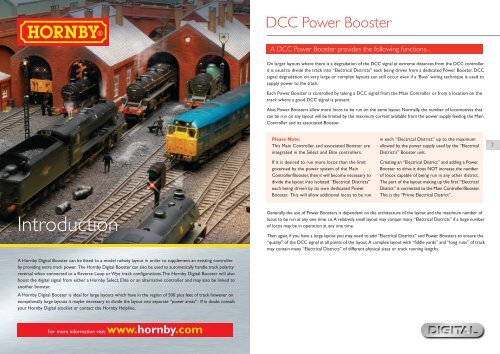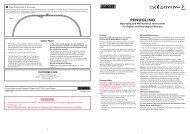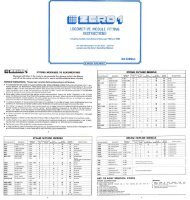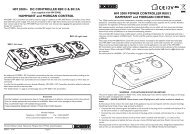R8239 DCC Booster English Only - Hornby
R8239 DCC Booster English Only - Hornby
R8239 DCC Booster English Only - Hornby
Create successful ePaper yourself
Turn your PDF publications into a flip-book with our unique Google optimized e-Paper software.
Introduction<br />
A <strong>Hornby</strong> Digital <strong>Booster</strong> can be fitted to a model railway layout in order to supplement an existing controller<br />
by providing extra track power. The <strong>Hornby</strong> Digital <strong>Booster</strong> can also be used to automatically handle track polarity<br />
reversal when connected to a Reverse Loop or Wye track configurations. The <strong>Hornby</strong> Digital <strong>Booster</strong> will also<br />
boost the digital signal from either a <strong>Hornby</strong> Select, Elite or an alternative controller and may also be linked to<br />
another booster.<br />
A <strong>Hornby</strong> Digital <strong>Booster</strong> is ideal for large layouts which have in the region of 500 plus feet of track however on<br />
exceptionally large layouts it maybe necessary to divide the layout into separate “power areas”. If in doubt consult<br />
your <strong>Hornby</strong> Digital stockist or contact the <strong>Hornby</strong> Helpline.<br />
For more information visit: www.hornby.com<br />
<strong>DCC</strong> Power <strong>Booster</strong><br />
A <strong>DCC</strong> Power <strong>Booster</strong> provides the following functions...<br />
On larger layouts where there is a degradation of the <strong>DCC</strong> signal at extreme distances from the <strong>DCC</strong> controller<br />
it is usual to divide the track into “Electrical Districts” each being driven from a dedicated Power <strong>Booster</strong>. <strong>DCC</strong><br />
signal degradation on very large or complex layouts can still occur even if a ‘Buss’ wiring technique is used to<br />
supply power to the track.<br />
Each Power <strong>Booster</strong> is controlled by taking a <strong>DCC</strong> signal from the Main Controller or from a location on the<br />
track where a good <strong>DCC</strong> signal is present.<br />
Also, Power <strong>Booster</strong>s allow more locos to be run on the same layout. Normally, the number of locomotives that<br />
can be run on any layout will be limited by the maximum current available from the power supply feeding the Main<br />
Controller and its associated <strong>Booster</strong>.<br />
Please Note:<br />
This Main Controller and associated <strong>Booster</strong> are<br />
integrated in the Select and Elite controllers.<br />
If it is desired to run more locos than the limit<br />
governed by the power system of the Main<br />
Controller/<strong>Booster</strong>, then it will become necessary to<br />
divide the layout into isolated “Electrical Districts”<br />
each being driven by its own dedicated Power<br />
<strong>Booster</strong>. This will allow additional locos to be run<br />
in each “Electrical District” up to the maximum<br />
allowed by the power supply used by the “Electrical<br />
District’s” <strong>Booster</strong> unit.<br />
Creating an “Electrical District” and adding a Power<br />
<strong>Booster</strong> to drive it does NOT increase the number<br />
of locos capable of being run in any other district.<br />
The part of the layout making up the first “Electrical<br />
District” is connected to the Main Controller/<strong>Booster</strong>.<br />
This is the “Prime Electrical District”.<br />
Generally the use of Power <strong>Booster</strong>s is dependent on the architecture of the layout and the maximum number of<br />
locos to be run at any one time. i.e. A relatively small layout may contain many “Electrical Districts” if a large number<br />
of locos may be in operation at any one time.<br />
Then again, if you have a large layout you may need to add “Electrical Districts” and Power <strong>Booster</strong>s to ensure the<br />
“quality” of the <strong>DCC</strong> signal at all points of the layout. A complex layout with “fiddle yards” and “long runs” of track<br />
may contain many “Electrical Districts” of different physical sizes or track running lengths.<br />
2





